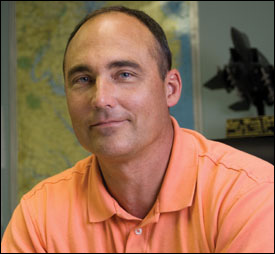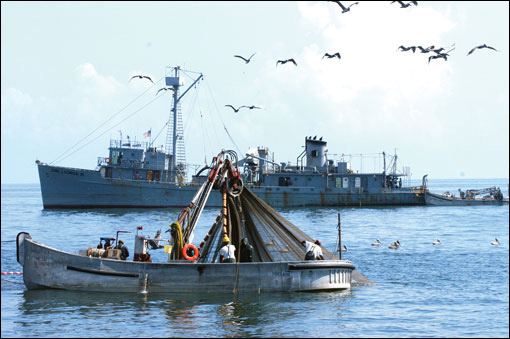|
The Case for Fishing Menhaden

Monty Deihl, general manager for the Omega Protein plant in Reedville, Virginia, is the fourth generation Deihl to work in the menhaden industry. Photograph by Michael W. Fincham.
COULD CUTTING BACK ON COMMERCIAL HARVESTS help restore menhaden stocks to a healthy level? Probably not, according to Monty Deihl, the new general manager of the Omega Protein plant in Reedville, Virginia. "We catch a very small percentage of the stock each year, very small," says Deihl, whose father, grandfather, and great-grandfather once worked the menhaden boats. "We've done this for 130 years, and now there is less fishing pressure on this stock than ever before."
A tall man, with wide shoulders, a broad face, and a confident style, Deihl is a Reedville native, but he took over as manager only two years ago after a long career with the Air Force and a short career with a defense contractor. He came back to an industry that has shrunk from 20 menhaden reduction plants located along the Atlantic Coast in the 1950s to 1: the Omega Protein plant he now manages. Since 1997, the menhaden fleet has dropped from 20 vessels fishing the Chesapeake and the mid-Atlantic Coast to 9 this year. And its harvests are running 30 percent below the previous decade.
He quickly found that part of his new job was building a better public case for commercial fishing, a case he based, in part, on claims about the small impact of commercial fishing and the large impact of environmental forces. "If this species is threatened, it certainly is not from us," says Deihl, sitting in his office at the Reedville plant. "It is from the same environmental factors that are threatening most other fisheries."
Turning to fishery science for support, he dug up some findings that helped his cause — and some that didn't. Scientists who track the menhaden fishery have documented a series of booms and busts in menhaden populations that seem to occur in cycles and play out over a decade or more. Populations surged in the 1950s, only to decline in the 1960s. They began rising again during the late 1970s and early 1980s, only to decline anew in the 1990s. (See menhaden abundance graph) Those cycles, recent research suggests, depend on the sudden appearance of large year classes that swell population counts.
Those large year classes, however, remain hard to predict. Since menhaden spawn in the ocean zone between the Gulf Stream and the nearshore, it's a combination of currents and weather and wind that delivers — or fails to deliver — menhaden eggs and larvae into nursery areas like the Chesapeake. Driving those year-class explosions are complicated, large-scale environmental factors like changes in water temperatures caused by the Atlantic Multi-decadal Oscillation and changes in air pressure caused by the Bermuda Azores High. All of which remain poorly understood — and largely beyond the control of fisheries managers. (See Where Have All the Menhaden Gone?)
"It is the environmental conditions that make or break the fishery," says Deihl, "not the stock, not the fishing." And not a cutback in commercial harvests. "If the environmental conditions are not right," he says, "then [the cutback] did not matter anyway." Then the decline continues, the cutbacks are wasted, and profits are lost.

The hunt for menhaden starts with a spotter plane (above, lower left) and a pilot who can fly on a tilt, scout out schools of fish, and guide a large fishing vessel to its prey. Each vessel launches two skiffs to encircle the school with a purse seine net, draw the net together, and steer the fish load back to the big ship. There the fish are vacuumed into refrigerated holds. Many of the ships in the menhaden fleet are oft-converted vessels that began their lives as military transports. The FV Earl J. Conrad Jr. (above top) served in the Pacific during World War II and Korea. Various ship historians believe the vessel also had a brief career under another name as a pirate radio ship broadcasting rock and roll music during the 1960s to fans in England and Europe. Photographs: above top, and middle and bottom right, www.oceansart.us; bottom left, Omega Protein.
If the environmental forces do create a boom cycle? Then the cutbacks would still not be necessary, according to Deihl. "What was there in the first place was plenty to sustain the stock," he says. After all, those forces were apparently able to drive boom years for menhaden in decades past when fishing pressure was much heavier.
It's a forceful argument as he delivers it, but one that slights some other findings from fishery research. More spawners would mean more eggs and larvae in coastal waters that could be moved shoreward when and if all the right forces finally line up. "Schooling fish can respond very rapidly to favorable conditions," says Dave Secor, a fishery researcher with the Chesapeake Biological Laboratory who has been studying the dynamics of juvenile recruitment. "They can suddenly break out into new foraging conditions or break out of predation [pressures] and have a big spatial expansion. This is a common pattern for schooling fish like menhaden, herring, and anchovies." More spawners might magnify a boom year.
That is the bet behind the harvest cutbacks proposed by the Atlantic States Marine Fisheries Commission. Although current fishing pressure has declined, as Deihl says, it's only allowing 8 percent of menhaden to make it to year three, the year when menhaden become effective spawners. The proposed harvest cutback could raise that spawning potential to 15 percent of the stock — still well below the spawning level that many scientists and most environmentalists would like to see.
Deihl's economic argument is simpler. A cutback on harvest would be a bet on unpredictable environmental forces — an uncertain bet that would put at risk the profits of a company that employs 300 people, provides work to thousands of contractors, and has a $45-million-dollar economic impact in Virginia.
Omega is still able to squeeze good profits out of declining harvests because of its success in finding new uses for fish oil — especially in health supplements containing omega-3 fatty acids. To earn those profits, the company was operating nine large vessels and eight spotter planes during 2011. Those boats and planes work in the Chesapeake Bay and along the offshore waters of New Jersey, Delaware, and Maryland, states that prohibit commercial netting inside the three-mile, state-managed fishery zone. Virginia and North Carolina are now the only East Coast states that still allow menhaden fishing in their coastal waters.
The largest chunk of Omega's catch, however, is coming from Virginia's ocean waters and from its portion of the Chesapeake Bay. And that's where the loudest complaints are now coming from as recreational fishermen in the state are campaigning hard to reserve menhaden as the primary food for striped bass, weakfish, and bluefish, their target species.
— Michael W. Fincham
|